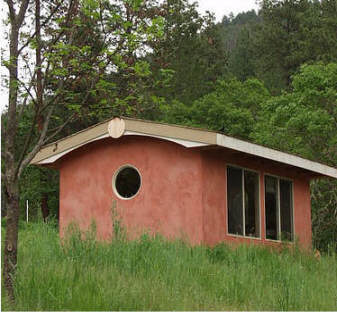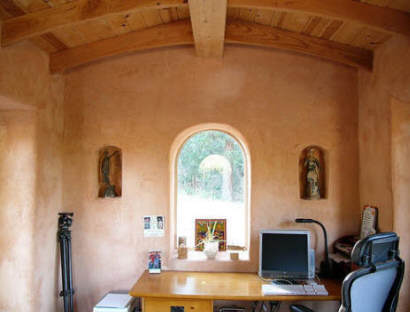
Search
The Renewable Energy site for Do-It-Yourselfers
Straw Bale
Construction DVDs
|
I recently had a chance to view the set of
DVDs that
www.Strawbale.com offers. This is a set of three DVDs intended for
owner builders who want to build their own straw bale house.
This page is a brief review of these DVDs.
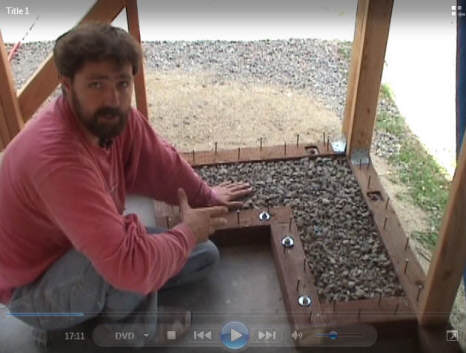
|
|
There are three DVDs:
Building a Monolithic Concrete
Slab Foundation
Building with Straw Bales (Post
and Beam Infill)
Plastering With Natural Hydraulic
Lime (NHL)
I should say up front that while I've
done construction projects as large as building a barn/shop, I've not (yet)
built a home. Since the DVDs are intended for new owner builders, maybe
this makes me a good person to do the review :)
All three DVDs are conducted by
Andrew Morrison. Andrew has a long background in straw bale construction,
and (probably more important) is a good teacher. There is a surprising
amount of detail to get right in straw bale construction, and Andrew does a
great job of getting the material across to people with little to no experience
in this area.
I did view all of all three DVDs
start to finish, which probably says a lot for Andrew's teaching abilities.
The example building used in the DVDs
is the a small straw bale cottage shown just below. Basically the DVDs go
through most of the construction of this cottage. In some cases, other
larger projects are used to show some things that don't come up in the cottage.
The "Building With Straw Bales (Post
and Beam Infill)" DVD
This DVD
covers the all the material associated with selecting and testing bales,
preparing the frame and base for the bales, handling windows and other openings,
cutting and tying bales, stuffing loose areas, flashing windows, and placing the
bales -- lots of "stuff".
The other two videos cover the
slab foundation and the plastering of the bales.
You've probably seen the
pictures that show how a bunch of people can stack bales -- this goes very fast,
and looks easy. But, there are a lot of details that are not obvious, and that
you need to get right to have a home that will stand up well to the weather and
be safe from fire and earthquakes. To me, the biggest plus of this DVD is that
it covers all these important details in detail.
Getting The Details Right
Anyone can throw up a bunch of
bales and make a home, but its getting all these details right that make it a
home that performs well, looks good, and lasts a long time. It was
surprising to me how many things there are that you could easily get wrong :)
Andrew
provides good, easy to follow instructions on all of these areas (and more)...
Getting the base for the
bales installed right and anchored well.
Window
installation and flashing to avoid moisture problems.
How to
meet current engineering requirements with correctly reinforced plaster --
using welded wire mesh.
How to
stuff straw into areas that otherwise would not have sufficiently dense
straw for insulation or fire safety.
How and
where to install plumbing.
Electrical
details -- running wire, type of wire, and how to mount boxes with the wood
"spike".
Securing
interior partitions to the exterior straw bale walls.
Providing
for hanging cabinets.
Rain
protection of the bottom bales.
Installing
windows in such a way as to protect from exterior moisture from getting into
the bale walls.
Lots of details that just
have to do with making the end product look good.
The main value
of some of the DVD material is to give you a good and time effective method to
get things done correctly, but some of the DVD material covers areas that are critical
for the structural integrity, fire resistance, and longevity of the
building.
A few pictures just below show
a small sampling of some of the details covered in the DVD.
|
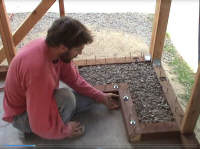
Preparing the base for the bales. |
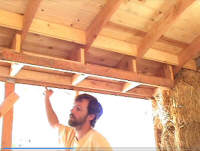
How to treat the areas above
the windows. |
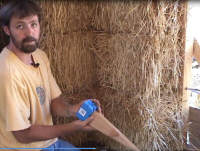
Installing electrical boxes. |
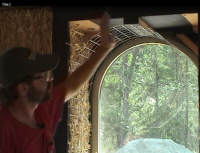
Straw and mesh placement
in the areas around windows. |
Each of these
areas (and many more) are explained clearly patiently by Andrew -- I'm guessing he has a lot of
workshop time showing not so experienced people how to do these things.
The DVD is a
couple hours long, and there is really not a wasted minute in it. All the
dozens of details you need to do the job right are described and demonstrated
clearly.
The "Building A Monolithic Concrete Slab
Foundation" DVD
This DVD covers building the monolithic slab foundation. This
is a type of combined foundation and floor slab that avoids the need to do a
separate foundation and floor pore. Around here people call it a thickened
edge slab.
The foundation DVD goes over the site prep,
forming, gravel bed prep, poring and finishing of the thickened edge slab for
the straw bale cottage. After this, it covers some of the issues that come up in
larger slabs that might be typical of a full sized house -- things like in slab
plumbing and electrical, load bearing interior walls, radiant floor heating
loops, crack control, stamped surface treatments, coloring, ... All of these are
covered in quite a bit of detail using videos from several larger slab projects.
There is also quite a good section on coloring and patterning the slab.
I've done several foundations, including a thickened edge slab, but I still picked
up quite a few new tips and insights watching the foundation video. If you are planning to use a thickened edge slab
type of foundation and floor, this is a
really good video to help you do it right.
I have to say that Andrew is a pretty calm guy
-- he does not even get excited during the concrete pore :)
The "Plastering With Natural Hydraulic Lime
(NHL)" DVD
This DVD covers the plastering process using
Natural Hydraulic Lime plaster.
There is a lot to learn on straw bale
plastering, and I think the video will be a big help in shortening the learning
curve. There is also a lot of labor involved in plastering, and the DVD
shows a number of techniques that will make you more efficient.
I won't go through all the details on this
video, but, like the others it covers all the steps in preparing and applying
the plaster in a clear and easy to understand way.
Final Thoughts
Its very clear
that the Andrew has a lot experience in building straw bale homes and has worked
out a lot good and reliable techniques. He also teaches very well.
I recommend these DVDs without
reservation to anyone who has in mind building a straw bale home.
They will save you time and keep you from making mistakes.
If I had any small nitpicks with
the videos they might be that the building of the post and beam frame and the
mating of the roof to the top of the walls might have been covered in a bit more
detail. But, these are very small nitpicks to a really excellent set of videos.
One other thing to consider is that Andrew picks
one type of straw bale construction and goes through it in full detail -- he
does not attempt to cover all of the many alternative straw bale construction
methods. I think this is a good
approach because you get a very good how-to on this method. It would just
be impossible to cover all the variations on straw bale construction to any
useful level of detail in three DVDs. If you
are looking for something that covers all the many different variations of straw
bale construction, you might want to start with a book and then decide if this
is the right set of videos for what you decide to build.
There are a lot of other things going on at
StrawBale.com that are
worth checking out.
Gary July 28, 2010


